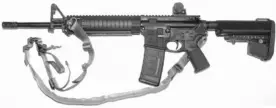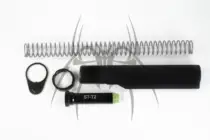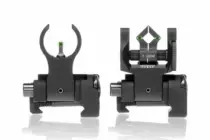Part 4: (Build Options) With the large military and civilian gun markets in the United States, there are a large number of manufactures of the AR-15 style carbine. Each manufacturer has their own take on quality and design. We will look at some of the more common build options for the survival carbine.
This article is Part 4 in a series of posts.
Read Part 1: (A Little Background)
Read Part 2: (History)
Read Part 3: (Direct Gas Impingement (DI/DGI) vs. Gas Piston Operated)
Most of these survival carbines can be purchased in various configurations, regardless of their operating system (Piston or Direct Gas Impingement). Typically choices range from the original carrying handle style upper to the monolithic upper receiver, caliber variations (5.56mm, 6.5mm, 6.8mm SPC, & 7.62mm), barrel twist (1:7, 1:8, 1:9, etc.), different compensators & flash suppressors, sight options and types of barrels and treatments (chrome lined, stainless steel, etc.)
SKIP AHEAD
Common Build Options
Upper Receivers
Monolithic Uppers offer more space to mount optics, laser sites, flashlights 
Also, it seems that the more room you have the more stuff you mount. On the other hand, flat top uppers usually offer a little bit of the best of both worlds. With the classic fixed front hard site, you can add a scope as well 
There are also a number of people who have went back to the classic carrying handle style AR-15. In a survival situation there would be little to go wrong with these rifles (scopes, lights, lasers, etc.). A good example of this is how former Delta Force Operator Paul Howe builds his personal rifle, not a lot of flash, just fixed front sights and rear sites (click here to see video).
Lower Receivers
It’s best to stick with MIL-SPEC on these so that you will have the option to interchangeably mount upper receivers without compatibility issues. A typical AR15 / M4 / M16 MIL-SPEC lower receiver can accept a wide variety of magazine options (USGI, P-Mags, C-Products 7.62×39 mm) that have been designed to feed the rifle different ammunition depending on the upper receiver’s barrel and bolt carrier group.
Chambering
5.56 mm is the standard chambered round for AR15 / M4 / M16 type weapon platforms, however, the terminal ballistics have been a source of continual dissatisfaction for some operators and there are some different options being fielded recently to include 6.5 mm, 6.8 mm SPC and also 7.62×39 mm.
All of these rounds have the capability being loaded into their respective magazines (or, in some cases, even a standard GI 5.56 magazine as long as only a few rounds are used) and fit functionally into the magazine well of a MilSpec M4 / M16 lower receiver. The only two things that typically need to be changed out are the barrel and bolt carrier group.
Barrel Twist Options
Barrel twist optimization depends on the weight/grain of the round being used with 1:7 twist being better suited for heavier rounds (60 GR to 75 GR) and 1:9 or greater being better suited for lighter rounds (55 GR or less). 1:8 has been reported to be a good twist rate for handling a wider range of bullet grains. 1:7 is the standard military/MilSpec twist rate for their M4 rifles. The ratio X:Y stands for X twists/turns of the bullet every Y inches of barrel length.
Barrel Material Options
Typically two main choices are offered, chrome lined or stainless steel. A chrome lined barrel tends to last longer, is more robust and able to handle heavy rates of fire under extreme conditions but is reported to be less accurate than stainless steel.
Barrel Length Options
Differences in barrel length effect:
- portability and maneuverability
- muzzle velocity (you tend to lose around 50 fps/feet per second every inch shorter under 18” or so because longer barrels tend to give propellant more time to work on the bullet before it exits)
- ballistic performance (how fast the round exits the barrel has a major effect on performance)
- weapon reliability and function (when using a DI/DGI weapon around or under 10” and/or suppressed, there can be a high incidence of cycling problems).
Typically ideal length for a combat carbine is anywhere between 12.5” – 16”. Longer or shorter barrels are also good for special applications (shorter for CQB/Close Quarter Battle and longer for DMR/Designated Marksmen Rifle applications).
Due to legal restrictions unless you obtain an NFA tax stamp to own an SBR (Short Barrel Rifle is any rifle with a barrel less than 16”) you will need to either stick with a 16” or longer barrel or buy one with a 14” barrel and get the compensator pinned (pinning is a “permanent” method which attaches the compensator to the barrel so that it cannot be removed thereby becoming part of the barrel and complying with the National Firearms Act). A good way to expedite and obtain an NFA stamp for Federally regulated firearm items is through an NFA Gun Trust.
Muzzle Compensator/Flash Suppressor
These can be a permanent part of the barrel or they can be changed out (if they are not permanently attached). Depending on their design they can address and reduce the flash that comes out of the angry end of a rifle barrel or they can address the tendency of the force from the exiting round to try and push the end of the barrel around.
Some companies offer options for one or the other and some companies offer dual purpose/flash suppressing compensators.
Gas System Adjustments
Companies like Noveske, Sig Sauer and LWRC offer adjustment controls on their barrels that can be set to divert gas that is usually used to cycle the firing system. One of the main applications for this is when shooting with sound suppressors.
Trigger Assembly
There are several options for the trigger assembly out there: single stage stock trigger, adjustable single stage trigger, non adjustable two stage trigger, and an adjustable two stage trigger.
The adjustments that can be made are related to the amount of force that needs to be applied when pulling the trigger. Some shooters prefer more or less depending on their preference and application.
Two stage triggers tend to be better suited for DM / Designated Marksman roles while the single stage is more commonly used for CQB/close in fighting rifles. A company that has a great reputation for manufacturing top end triggers with excellent durability is Geissele Automatics.
Buffer Tube Assembly
There are options in the buffer tube assembly that come into play 
Sights
You can have fixed sights, pop-up sights or no sites at all. I would recommend having some type of sight on your survival rifle otherwise you will have a heck of time hitting what you’re shooting at and may waste a lot of bullets.
You can mount a scope on your rifle which comes in handy at distances (over 150 yards or more) but they leave a lot to be desired at close range.
A majority of shooters like to use Aimpoint, EOTech or some other type of electronic sight. These sights are great for ranges up to 150 yards and in. They can be used out past 150 yards as well but I actually start preferring some supplemental magnification much past that if it’s available (Trijicon’s ACOG’s are great multi-application sights especially when coupled with a Docter sight on top). If not, I know I can hit a man size silhouette at 500 meters with my iron sights so I don’t get too stressed out.
These electronic sights can be supplemented with a magnifier 3x or 4x optic mounted on the rail system and used for targets at distance (Click here to see an image of EOTech with Magnifier on LMT Rifle). The nice thing about these types of sights is that they allow for rapid engagement (especially Close Quarter Battle / CQB scenerios) as it’s fairly easy to put a dot on a target.
As long as you have proper shooting fundamentals, when you pull the trigger, the bullet will go where the rifle is aimed. The drawback for fancy electronic sights is that at some point they could fail and at the worst possible time (batteries could go bad, EMP, it could just plain break, you name it… electronics can be finicky) and although I think they are worth their weight in 
If you have a flat top upper or a monolithic upper, check out Troy folding battle sights for your Survival Carbine, they make a great set of back up hard sights.
On a side note, I also never go anywhere “important” just using a GPS for navigation, I always first make sure and pack my compass, same thing with hard sights – “Two is One and One is None.”
Bolt Carrier Group
Some of the newer gas piston systems offer alternatives to the classic DI bolt carrier group (BCG) parts systems such as the Advanced Combat Bolt offered by LWRC which is a one piece BCG or the single piece long stroke gas piston that is attached to the BCG and routed through the charging handle on the PWS systems.
Continue Reading: (Part 5) Commercially available DI/DGI Direct Gas Impingement Systems
Read Part 1: (A Little Background)
Read Part 2: (History)
Read Part 3: (Direct Gas Impingement (DI/DGI) vs. Gas Piston Operated)
Photo credits:
gunrunner1000.com
parallaxtactical.com
wikklytext.com
calguns.net

